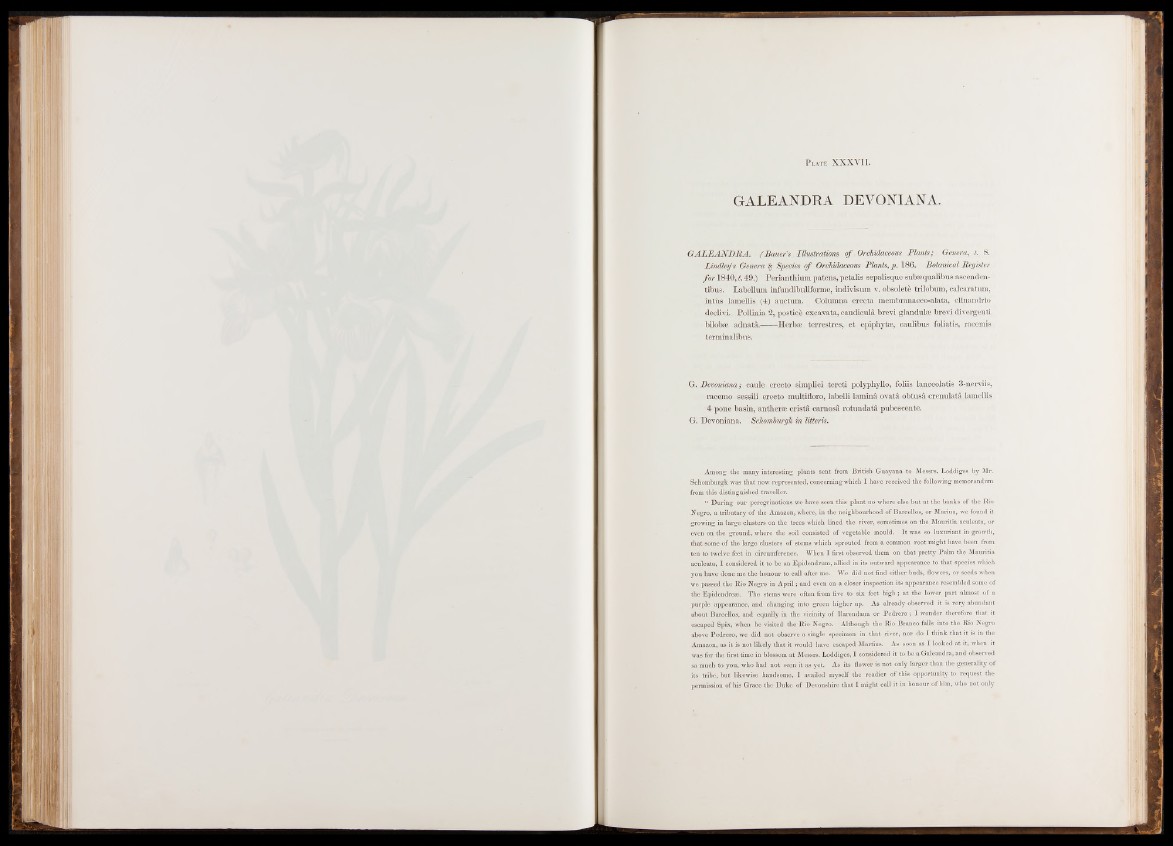
P late XXXVII.
GALEANDRA DEVONIAN A.
G A L E A N D R A : h ( Bauer's Illustrations of Orchidaceous Plants; Genera, t. 8.
Lindley’s Genera $ Species of Orchidaceous Plants, p. 186. Botanical Register
fo r 1840, t. 49.) Perianthium patens, petalis sepalisque subæqualibus ascenden-
tibus. Labellnm infiindibuliforme, indivisum v. obsoletè trilobum, calcaratum,
intùs lamellis (4) auctum. Columna erecta membranaceo-alata, clinandrio
declivi. Pollinia 2, posticè excavata, caudiculâ brevi glandulæ brevi divergenti
bilobæ adnata.------Herbæ terrestres, et epiphytæ, caulibus foliatis, racemis
terminalibns.
G. ÙDevoniana ;, caule erecto simplici tereti polyphyllo, foliis lanceolatis 3-nerviis,
racemo sessili erecto multifloro, labelli laminâ ovatâ obtusâ crenulatâ lamellis
4 pone basin, antheræ cristâ camosâ rotundatâ pubescente.
G. Devoniana. Schomburgk in litteris.
Among the many interesting plants sent from British Guayana to Messrs. Loddiges by Mr.
Schomburgk was that now represented, concerning which I have received the following memorandum
from this distinguished traveller.
“ During our peregrinations we have seen this plant no where else but at the banks of the Rio
Negro, a tributary of the Amazon, where, in the neighbourhood of Barcellos, or Mariua, we found it
growing in large clusters on the trees which lined the river, sometimes on the Mauritia aculeata, or
even on the ground, where the soil consisted of vegetable mould. It was so luxuriant in growth,
that some of the large clusters of stems which sprouted from a common root might have been from
ten to twelve feet in circumference. When I first observed them on that pretty Palm the Mauritia
aculeata, I considered it to be an Epidendrum, allied in its outward appearance to that species which
you have done me the honour to call after me. We did not find either buds, flowers, or seeds when
we passed the Rio Negro in April; and even on a closer inspection its appearance resembled some of
the Epidendrese. The stems were often from five to six feet high; at the lower part almost of a
purple appearance, and changing into green higher up, As already observed it is very abundant
about Barcellos, and equally in the vicinity of Ilarendaua or Pedrero; I wonder therefore that it
escaped Spix, when he visited the Rio Negro. Although the Rio Branco falls into the Rio Negro
above Pedrero, we did not observe a single specimen in that river, nor do I think that it is in the
Amazon, as it is not likely that it would have escaped Martius. As soon as I looked at it, when it
was for the first time in blossom at Messrs. Loddiges, I considered it to be a Galeandra, and observed
so much to you, who had not seen it as yet. As its flower is not only larger than the generality of
its tribe, but likewise handsome, I availed myself the readier of this opportunity to request the
permission of his Grace the Duke of Devonshire that I might call it in honour of him, who not only